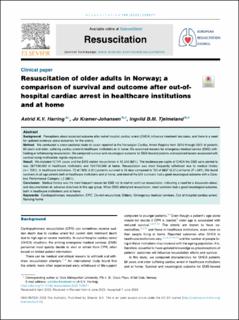Resuscitation of older adults in Norway; a comparison of survival and outcome after out-of-hospital cardiac arrest in healthcare institutions and at home
Peer reviewed, Journal article
Published version
Permanent lenke
https://hdl.handle.net/11250/3074664Utgivelsesdato
2023Metadata
Vis full innførselSamlinger
Originalversjon
https://doi.org/10.1016/j.resuscitation.2023.109871Sammendrag
Background
Perceptions about expected outcome after out-of-hospital cardiac arrest (OHCA) influence treatment decisions, and there is a need for updated evidence about outcomes for the elderly.
Method
We conducted a cross-sectional study of cases reported to the Norwegian Cardiac Arrest Registry from 2015 through 2021 of patients 60 years and older, suffering cardiac arrest in healthcare institutions or at home. We examined reasons for emergency medical service (EMS) withholding or withdrawing resuscitation. We compared survival and neurological outcome for EMS-treated patients and explored factors associated with survival using multivariate logistic regression.
Result
We included 12,191 cases and the EMS started resuscitation in 10,340 (85%). The incidence per capita of OHCA the EMS were alerted to was 267/100,000 in healthcare institutions and 134/100,000 at home. Resuscitation was most frequently withdrawn due to medical history (n = 1251). In healthcare institutions, 72 of 1503 (4.8%) patients survived to 30 days compared to 752 of 8837 (8.5%) at home (P <.001). We found survivors in all age cohorts both in healthcare institutions and at home, and most of the 824 survivors had a good neurological outcome with a Cerebral Performance Category ≤2 (88%).
Conclusion
Medical history was the most frequent reason for EMS not to start or continue resuscitation, indicating a need for a discussion about, and documentation of, advance directives in this age group. When EMS attempted resuscitation, most survivors had a good neurological outcome, both in healthcare institutions and at home.

